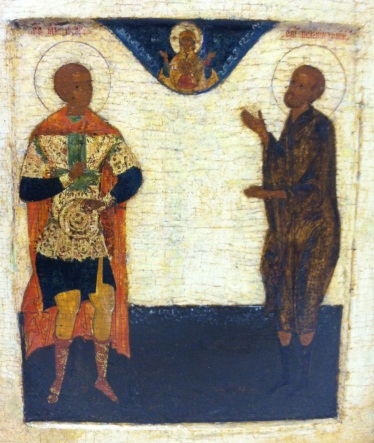
Unknown
Russian
St. George and St. Procopius with the Mother of God of the Sign, 16th c. ce.
egg tempera on wood panel
12 x 10 in.
SBMA, Anonymous Gift
1961.5.13
COMMENTS
Description
The youthful S. George appears here wearing his traditional military cuirass and red cape. He holds a circular shield and spear in his left hand and a Russian cross, symbolic of martyrdom, in his right. On the right, a bearded St. Procopius, dressed in a dark brown tunic, raises his right hand in supplication to the Virgin and Christ Child appearing in the clouds of heaven at the top of the icon.
Origin and Iconography
St. George, devotion to whom originated in Palestine was the most popular of the Christian military martyrs. He was believed to have lived in the third or fourth century. Of many legends that grew up around him, the most popular describes his as a Cappadocian knight who rescued a princess from a dragon in Libya and brought about the baptism of thousands of converts. His triumph over the dragon became a popular theme in Russian icon painting, and, in fact, became the emblem of Moscow. Here however, St. George appears in the role of supplicant, probably as a family saint.
St. Procopius, who died in 303, is mentioned in the accounts of the 4th century church historian Eusebius. We learn that he was born at Jerusalem but lived at Scytholpolis (Bethshan). He was much respected as a church reader, exorcist, and interpreter of Syriac. He was martyred under Kiocletian because he refused to sacrifice to Roman gods or to the emperors. Before being beheaded, he quoted Homer, “It is not good to have several masters: let there be one chief, one king.” Later legends describe Procopius as a duke of Alexandria who was converted in a manner similar to St. Paul’s conversion. When he declared himself a Christian, he was imprisoned and tortured. Just before his execution, so legends say, Procopius was baptized in a vision by Christ himself.
The image of the Mother of God and the Christ Child is a type known as “Mother of God of the Sign,” one of the most venerated icons in the Orthodox world. Mary raises her arms in prayer behind a bust of the Christ Child. This theme appears very frequently on the Russian iconostas above the Festival row in the Prophet story. The earliest known image of this type goes back to the fourth century in the Roman catacombs of Cimitero Majore. A later variation shows the Christ Child enclosed within a circular Mandoria on the breast of the Virgin Mary. The title derives from a prophecy of Isaiah, who is frequently called the “fifth Evangelist”: “therefore the Lord himself will give you a sign: A young woman is with child, and she will bear a son, and will call him Immanuel (God is with us).” (Isaiah 7:14)
Style
Although it is not always easy to distinguish between the styles of the Moscow and Novgorod Schools in the 16th century, the proportions of the standing figures and the strong colors used in the costume of St. George point clearly to the Novgorod School.
- Robert Henning, Jr., "Russian Icons in Santa Barbara," Santa Barbara Museum of Art, 1982
Bibliography
Alpatov, M.V., Early Russian Icon Painting, Moscow, 1974, pl. 89.
McKenzie, A.D., Greek and Russian Icons, Milwaukee, 1966, pl. 10, pp. 26-27.
Ouspensky, L. and Lossky, V., The Meaning of Icons, 1952, pp. 78-79, 81.
Onasch, K. Icons, London, 1961, pls. 18, 114; pp. 351-52, 391.
